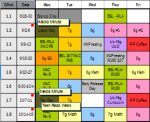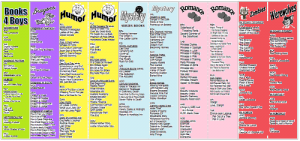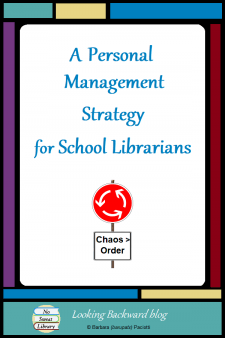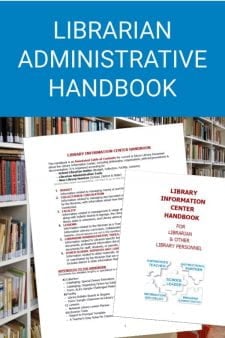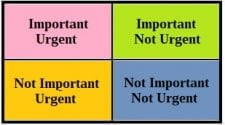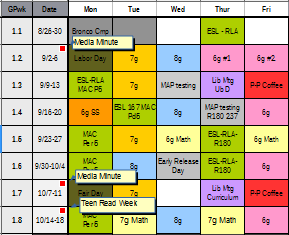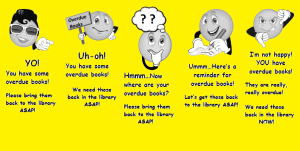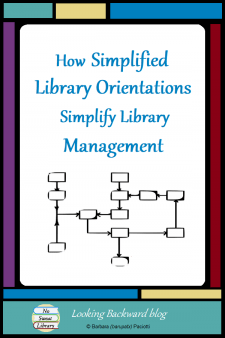 I’ve written about my simplified Library Orientations with English Language Arts classes, that focus only on reading and narrative literature so students can check out their first Fiction book. Eliminating everything else from orientation gives students a pleasurable visit and makes ELA teachers avid library supporters.
I’ve written about my simplified Library Orientations with English Language Arts classes, that focus only on reading and narrative literature so students can check out their first Fiction book. Eliminating everything else from orientation gives students a pleasurable visit and makes ELA teachers avid library supporters.
Throughout the rest of the year I began to see that simplified Library Orientations also simplify Library Management: scheduling, facility organization, collection development, library promotion, and even my own professional development.
SIMPLIFIED LIBRARY SCHEDULING
Establishing sustained, silent reading at library orientation so students can begin reading their book means students are more quickly engaged in the story, are reading more, and need to exchange finished books for new ones more often. Having DEAR Time during ensuing visits convinced my ELA teachers to schedule regular class library visits throughout the school year. Now we have an “ELA Book Exchange” day, every other week, for each grade level and for SpEd/ESL/Reading Improvement. I schedule a semester of visits and send event emails to teachers that automatically add the dates into their online calendars.
This scheduling—fixed for ELA, flex for everyone else—has been a perfect solution for our library. ELA teachers are very adaptable if we have to change for another library need, but this regular visitation has allowed me to create short Library Lessons featuring library materials for each new ELA unit: expository text, persuasion, and poetry.
SIMPLIFIED FACILITY ORGANIZATION
My goal for the organization and arrangement of library materials is to minimize the time it takes students to find something they need. Simplifying library orientations led to an ongoing library re-organization and re-arrangement that promotes reading, supports subject curricula, and makes the School Library more student-friendly.
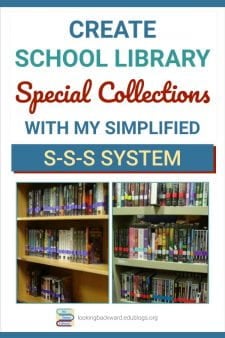 Students like the Special Collections I feature at orientations because their smaller size and specific topics simplify finding a book that interests them. Teachers like these customized reading choices because they support curriculum and reduce the time students spend searching for books during visits.
Students like the Special Collections I feature at orientations because their smaller size and specific topics simplify finding a book that interests them. Teachers like these customized reading choices because they support curriculum and reduce the time students spend searching for books during visits.
Before creating my first special collection I thoroughly planned how to do it: I applied a Subject sticker under the spine label, a transparent color symbol or label protector over the Call Number spine label, and shelved the books together with colorful customized signs and shelf labels. This S-S-S System—stickers, shelving, and signage—is simple and fast, and anyone can sort books for re-shelving with a quick glance at the sticker or color label … as in, “Judy, I need you to shelve all the ‘red’ label books.”
I’ve written about some of my Special Collections, but here’s a list of all of them, in the approximate order I created them over the years:
- Texas State Reading List collections – the middle school Lone Star books and selected high school Tayshas books.
- Careers – books pulled from other Dewey sections and shelved together under the 331.7 Dewey books; they’re easy to locate for pleasure reading and for the Careers class project.
- Multicultural Fiction – I added stickers at the top of the spine, but decided not to separate these books from the rest of the fiction collection.
- Graphic Novels—fiction and non-fiction plus Manga series.
- Picture Books and Quick-Reads (easy-readers & books <100 pages) – I moved Picture Books, Quick-Reads, and Graphic Novels to adjacent shelves, and by featuring these Special Collections at ELL, SpEd and Reading Improvement orientations, I help these students progressively build language and reading skills.
- Quick-Bios (books <100 pages) for ELL, SpEd and RI, and Memoirs, a curriculum topic for 8g ELA.
- Spanish Language Fiction and Spanish Language Dewey collections to support our IB language program. Spanish teachers schedule a Library Lesson for students to learn about, and check out books from, these collections.
- Multicultural collections in 973.04 for Multicultural U.S. History (Civil Rights movement, etc.) and on the shelf right below, 973.08 for Multicultural America (.08 is for “kinds of people”).
- Fiction Subjects: Adventure, Fantasy, Historical Fiction, Humor, Mystery, Realistic Fiction, Romance, Scary (Horror), Science Fiction, and Sports.
- Special Social Studies Collections: GlobeTrekkers (fiction & Dewey sorted by continent), Totally Texas (Texas Fiction & 976.4), and Read America (Historical America fiction & 973)
DEAR Time during ELA visits prompted me to add additional furniture and create special seating areas in the library. I now have a chair or bench at the end of each aisle so students can look over books. Students can sit in a solitary chair to read by themselves or in one of the small group seating areas I created. I didn’t use library funds—I raided the district warehouse for discards, accepted donated chairs from parents, and donated a couple of my own. Even the theater teacher gave me seating items to clear out her props room, yet they are readily available when she needs to borrow them back for a performance!
SIMPLIFIED COLLECTION DEVELOPMENT
Simplified Library Orientations and Special Collections makes collection development easier because I know exactly what to look for in catalogs and book reviews. The first expenditures from my book budget are for Special Collections, so I can keep them fresh and inviting to students. With vendors I create a separate book list for each Special Collection. After ordering, I print out each collection list so when books arrive I can quickly separate and label one group at a time.
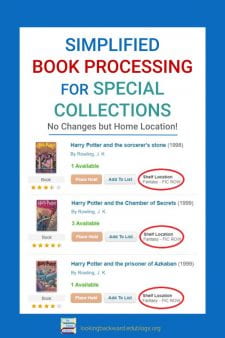 My district has a standard for book processing, cataloging, and spine label call numbers, so using only stickers and transparent labels to identify Special Collection books means NO changes to call numbers or spine labels. In my automation system I’ve added Special Collection names to the Home Location field—the one that shows when a book is on the shelf or checked out. I use the global batch feature to set each name so I can scan all the new books in each collection at one time. An online catalog search displays the Home Location field so viewers know that a book is in a Special Collection location (or that it’s checked out). It’s also very easy to generate customized reports using that field:
My district has a standard for book processing, cataloging, and spine label call numbers, so using only stickers and transparent labels to identify Special Collection books means NO changes to call numbers or spine labels. In my automation system I’ve added Special Collection names to the Home Location field—the one that shows when a book is on the shelf or checked out. I use the global batch feature to set each name so I can scan all the new books in each collection at one time. An online catalog search displays the Home Location field so viewers know that a book is in a Special Collection location (or that it’s checked out). It’s also very easy to generate customized reports using that field:
- Circulation statistics show which collections are most popular and need more books or which titles need additional copies.
- Aged and low-circulation statistics allow me to quickly weed books throughout the year, one special collection at a time.
SIMPLIFIED LIBRARY PROMOTION
I’m not a bulletin board person. The 3 bulletin boards outside the library near each grade-level hallway were decorated at the start of school and left until the end of the school year. After customizing Library Orientations, I was inspired to create a bulletin board for each grade level that changes each grading period to coordinate with classroom activities and to promote reading and the library:
- A sign with the ELA grade-level theme for each changing unit, along with pictures of books related to that theme.
- A sign for the Social Studies grade-level theme, along with pictures of books to coordinate with classroom content. Each board has a pocket with grade-level Social Studies bookmarks so students can grab one if they need it.
- Signs and Dewey-book pictures for subject area library visits scheduled for the grading period, along with signs or infographics of online services for research projects that bring those subject area classes to the library.
- When students talk about a good book, I have them create a book review on a 3”x5” card and staple it on the board. It’s a great way to involve students and to update bulletin boards without a lot of extra work.
Changing the focus of orientations to reading also prompted me to create my own customized Reading Records and Series & Topical Fiction bookmarks. Using letter-size color card-stock I can create 6 bookmarks with lists of books on both sides. From a ream of card-stock I get ~3000 bookmarks for the same price as 500 from library suppliers. I also customize bookmarks for Lexiled reading lists for ELL/SpEd/Reading Improvement classes and for research project print & online resource lists.
SIMPLIFIED PROFESSIONAL DEVELOPMENT
I’ve written before about my science and social studies background, which helps for choosing non-fiction books and coordinating content reading into lessons, and except for mystery fiction, I even prefer reading non-fiction. Consequently, following orientation changes, my professional development included learning more about ELA standards, about reading levels for students and books, and about reading promotion. I’ve read professional books, attended workshops, and indulged in librarian blogs featuring books and reading promotion. I’m also more attentive to book reviews and recommendations from other librarians in my district and on the listservs. I’m still not as adept at reading promotion as someone who came from an ELA background, but every step forward improves student use of our library, the circulation of books, and most importantly, my ability to help students find a perfect book to read.
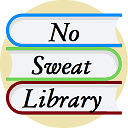
For products that support facility organization and library lessons check out No Sweat Library, my TPT store.

